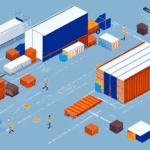Creating a Robotic 3PL Fulfillment Roadmap for Success
As the logistics and supply chain management landscape evolves, third-party logistics (3PL) providers are increasingly integrating robotics into their fulfillment processes. The benefits of robotic 3PL fulfillment include enhanced efficiency, higher productivity, and cost reductions. However, successful implementation demands meticulous planning and strategic design. This is where a 3PL fulfillment roadmap becomes essential.
The Importance of a Fulfillment Roadmap in 3PL
A comprehensive 3PL fulfillment roadmap outlines the necessary steps to seamlessly integrate robotics into existing fulfillment operations. This roadmap acts as a blueprint, allowing logistics providers to anticipate potential challenges and align robotic integration with their business objectives for sustainable, long-term success.
Key benefits include:
- Improved operational efficiency and reduced costs through automation of repetitive tasks.
- Minimized risk of errors and delays, leading to faster and more accurate order fulfillment.
- Enhanced competitive advantage by meeting the growing demand for faster and more efficient fulfillment.
Implementing a well-designed roadmap ensures that logistics providers can adapt to the rapidly changing industry landscape and meet the evolving needs of their customers.
Understanding the Basics of Robotic 3PL Fulfillment
Robotic fulfillment in 3PL involves the use of autonomous vehicles, robotic arms, and other automated technologies to perform various tasks such as inventory management, order picking, packing, and shipping. The primary advantages include increased efficiency and accuracy, leading to faster delivery times and improved customer satisfaction.
However, implementing robotic fulfillment requires significant investment in technology and infrastructure. Additionally, there may be concerns regarding job displacement and the need for employee retraining. It's essential to carefully assess the costs and benefits before adopting robotic solutions in your business.
According to a McKinsey report, automation can enhance productivity by up to 30% in logistics operations.
Advantages of Incorporating Robotics in 3PL Fulfillment
Integrating robotics into 3PL fulfillment offers numerous advantages:
- Increased Efficiency and Productivity: Robotics streamline operations by handling high volumes of orders with speed and accuracy.
- Cost Reduction: Automation reduces labor costs and operational expenses.
- Enhanced Accuracy: Robots minimize errors in tasks like inventory management and order picking, improving customer satisfaction.
- Workplace Safety: Robotics reduce the need for manual labor in hazardous tasks, promoting a safer work environment.
- 24/7 Operation: Automated systems can operate continuously, ensuring faster order turnaround times.
Furthermore, robotics enable real-time tracking and monitoring of shipments, providing customers with up-to-date information and enhancing transparency.
Key Elements to Consider When Designing a 3PL Fulfillment Roadmap
Designing an effective 3PL fulfillment roadmap involves several critical elements:
Assess Operational Needs
Evaluate the current operational capabilities and requirements of your facility to identify areas where robotics can offer the most significant benefits.
Select Appropriate Technologies
Choose robotics technologies that align with your specific fulfillment tasks, such as autonomous mobile robots (AMRs) for inventory transport or robotic arms for order picking.
Design Scalable Solutions
Ensure that the selected technologies are scalable to accommodate business growth without disrupting fulfillment processes.
Cost-Effectiveness
Analyze the cost-benefit ratio of implementing robotic solutions, considering both initial investments and long-term savings.
Workforce Impact
Develop a strategy to address potential job displacement by providing training and upskilling opportunities for employees.
Additionally, consider integrating advanced software and data analytics to optimize workflows and enhance decision-making processes.
The Role of Technology in Creating a Successful Robotic 3PL Fulfillment Roadmap
Technology is pivotal in developing a successful robotic 3PL fulfillment roadmap. Advanced software and algorithms can optimize workflows, identify inefficiencies, and dynamically adjust fulfillment processes to maximize efficiency and throughput.
Key technological components include:
- Automation Software: Facilitates seamless integration of robotic systems with existing operations.
- Sensors and IoT Devices: Collect real-time data to monitor and manage fulfillment activities effectively.
- Data Analytics: Provides actionable insights to improve decision-making and operational efficiency.
- Real-Time Tracking Systems: Enhance transparency and allow for precise monitoring of shipments.
Implementing these technologies not only increases the speed and accuracy of order fulfillment but also builds trust and loyalty with customers through improved service quality.
According to a Forbes article, leveraging advanced technologies can lead to a 20% increase in logistics efficiency.
Maximizing Efficiency and Productivity with Robotic 3PL Fulfillment Solutions
To fully capitalize on robotic 3PL fulfillment solutions, logistics providers should adopt a holistic approach:
- Integrate robotics across all aspects of the fulfillment process, from inventory management to shipping.
- Continuously monitor and optimize processes to maintain peak efficiency.
- Utilize data-driven insights to make informed decisions and enhance operational workflows.
During peak seasons or unexpected demand spikes, robotic solutions ensure that order processing remains swift and accurate, mitigating the risk of delays and errors. This not only reduces labor costs but also positions logistics providers to offer competitive pricing and superior service quality.
Research from the Supply Chain Digital highlights that automation can lead to a 25% reduction in order fulfillment times.
How to Choose the Right Robotics Technology for Your 3PL Fulfillment Needs
Selecting the appropriate robotics technology is crucial for the success of your 3PL fulfillment roadmap. Consider the following factors:
Organizational Needs
Understand the specific requirements of your fulfillment operations, including the types of products handled, the volume of orders, and the layout of your facility.
Customization vs. Off-the-Shelf Solutions
Determine whether your operations require customized robotic solutions or if standard, off-the-shelf options suffice. Customized solutions may offer better alignment with your unique needs but can be more costly.
Vendor Reliability
Partner with reputable vendors who can provide reliable support, maintenance, and updates for the robotic systems.
Scalability and Flexibility
Choose technologies that can scale with your business growth and adapt to changing operational demands.
Integration Capabilities
Ensure that the selected robotics can seamlessly integrate with your existing software and hardware systems to facilitate smooth operations.
Engaging with industry experts and conducting thorough market research can aid in making informed decisions when selecting the right robotics technology.
Overcoming Challenges in Implementing Robotic 3PL Fulfillment Solutions
Implementing robotic 3PL fulfillment solutions presents several challenges, but with strategic planning, these can be effectively managed:
Initial Investment
The upfront cost of purchasing and installing robotic systems can be substantial. However, it's essential to consider the long-term benefits such as increased efficiency and cost savings. Financing options or phased implementation strategies can help mitigate the initial financial burden.
Integration and Compatibility
Ensuring that new robotic systems are compatible with existing processes and technologies is critical. Conduct thorough compatibility assessments and work closely with vendors to facilitate seamless integration.
Workforce Management
Address potential job displacement by developing comprehensive training programs for employees. Providing opportunities for upskilling and transitioning to new roles within the organization can enhance workforce morale and retention.
Maintenance and Support
Robotic systems require regular maintenance and updates to function optimally. Establish a maintenance schedule and ensure that you have access to technical support and expertise to address any issues promptly.
Building strong relationships with technology vendors and investing in ongoing training can help overcome these challenges effectively.
Measuring the Success of Your Robotic 3PL Fulfillment Roadmap
Regular evaluation of your robotic 3PL fulfillment roadmap is essential to ensure its effectiveness and to identify areas for improvement:
- Order Fulfillment Time: Track the speed at which orders are processed and shipped.
- Inventory Accuracy: Monitor the precision of inventory management and order picking.
- Customer Satisfaction: Assess customer feedback and satisfaction levels to gauge service quality.
- Cost Savings: Analyze reductions in operational costs and increases in profitability.
Utilizing key performance indicators (KPIs) and analytics tools can provide valuable insights into the performance of your robotic fulfillment solutions. Continuously refining and adjusting your roadmap based on these metrics will help maximize the benefits of your investment in robotics.
According to a study by Harvard Business Review, businesses that implement regular performance assessments experience a 15% higher success rate in robotics integration.
Conclusion
Developing a successful robotic 3PL fulfillment roadmap requires strategic planning, careful design, and effective execution. By leveraging the right technologies and addressing potential challenges, logistics providers can significantly enhance their efficiency and productivity while reducing costs and improving customer satisfaction. A holistic and adaptable approach ensures that organizations remain competitive in the dynamic world of supply chain management.
Additionally, investing in employee training and sustainable practices will not only optimize operations but also contribute to a positive workplace culture and environmental responsibility.




















